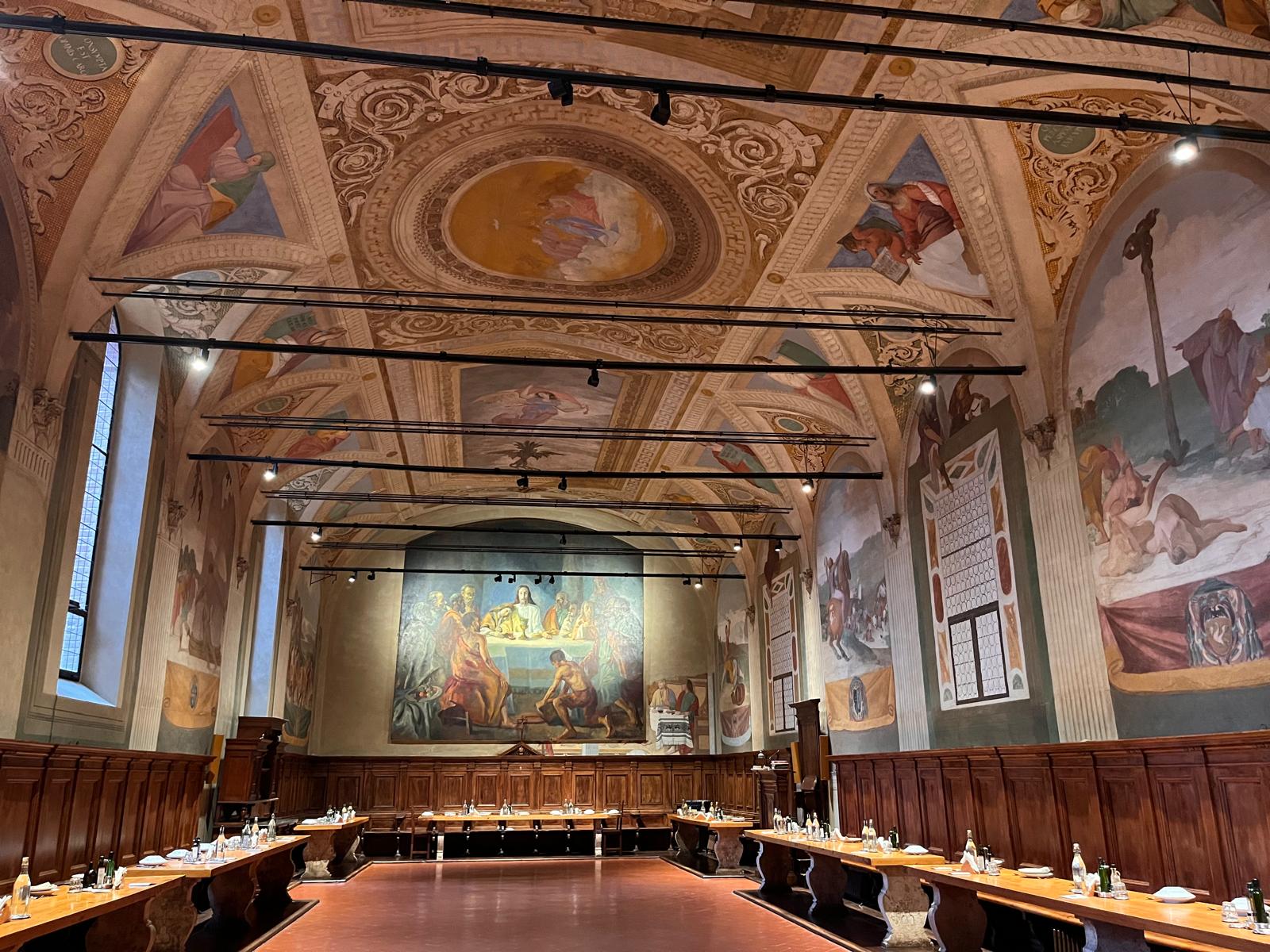"Like a green olive tree in the house of God, I trust in the mercy of God forever and ever." (Ps 52:10)
In the heart of the Crete Senesi, where nature seems to pray in silence, the Olivetan Benedictine monks have lived for over seven centuries on a hill that became a monastery, and a monastery that became a city of the spirit. The Abbey of Monte Oliveto Maggiore is not merely a place of stone, but a living witness to a charism that has crossed centuries without losing its generative power.
A root that is fire: Bernardo Tolomei
At the origin of everything, there is a man. His name was Giovanni Tolomei, a nobleman from Siena, who in 1313, blinded not only physically but by the vanity of a divided and superficial society, chose the desert of Accona to rediscover God. He took the name Bernardo, in honour of the great Cistercian abbot, and with two companions – Patrizio Patrizi and Ambrogio Piccolomini – began a life of silence, lectio divina, work, and fraternity. They were laymen, not priests, yet they burned with one desire: to live like the first monks of the Thebaid, in the light of the Gospel.
In 1319, with the approval of the bishop of Arezzo, the monastery of Santa Maria di Monte Oliveto was officially founded, under the Rule of Saint Benedict. They weren’t seeking a new spiritual trend: they were seeking God. And the monastic life was the highest expression of that thirst.
Charism: one single body
Pope Clement VI, in 1344, recognised the flame and approved the new Benedictine Congregation of Santa Maria di Monte Oliveto, which adopted a unique structure: one general abbot, one family. The monastery is not an island, but a communion of life. Even today, every monk entering an Olivetan house makes a vow of stability in the Congregation. It is a fraternal pact that transcends all individualism and builds authentic monastic solidarity.

Ora, lege et labora
The life of the Olivetan monks stands on three pillars, faithful to the wisdom of Saint Benedict: prayer, reading the Word, and manual labour.
The Opus Dei, the Liturgy of the Hours, is the heart of the day. Accompanied by Gregorian chant, during the conventual Mass and the Liturgy of the Hours, it is a prayer that brings peace to the soul and sanctifies time. The silence of the cloister becomes voice: the Church sings through them.
Lectio Divina is deep listening to Scripture. One does not read to know, but to encounter. The monk knows that God speaks, and like the disciples on the road to Emmaus, he too discovers that the Risen One is present in the broken bread and the meditated Word. “Reading, meditation, prayer, and contemplation,” wrote Guigo the Carthusian, “are the four rungs of his ascent.”
Work is not a complement, but an integral part of monastic life. The cultivated fields, the vineyards, the olive groves, the management of the agricultural estate: everything is aimed at caring for creation, making it prayer.
The light of the face of Christ
In 2009, declaring Bernardo Tolomei a saint, Benedict XVI said: "His was a Eucharistic existence, wholly dedicated to contemplation, expressed in humble service of others. [...] He left the solitude of Monte Oliveto to care for his monks afflicted by the plague and died as a true martyr of charity. From the example of this Saint comes the invitation to translate our faith into a life devoted to God in prayer and spent in service of our neighbour, moved by a charity ready even for the supreme sacrifice."
This light has not gone out. Even today, at Monte Oliveto, monastic life continues to sing Christ, to seek Him in fraternity, to serve Him in silence. It is a song that draws visitors, seekers, the restless, the weary, and leads them back to the source.
Solemnity of Saint Benedict: an invitation
In a time when everything seems to shout, the Abbey of Monte Oliveto Maggiore continues to whisper God. In this spirit of silent faithfulness, on Friday 11 July 2025, at 11:00 a.m., the Solemnity of Saint Benedict, father of Western monasticism, will be celebrated. The solemn Pontifical Mass, in the abbey church, will be presided over by His Most Reverend Eminence Cardinal Rolandas Makrickas, Coadjutor Archpriest of the Basilica of Saint Mary Major.
It will be a precious occasion to climb – even symbolically – that Mount of Olives where everything began: to be purified by the Easter splendour that radiates from the faces of the monks, from the scent of incense, from the chantthat rekindles our longing for God. In a world consumed by frenzy and distraction, liturgy and monastic life offer us an alternative path: to seek God each day, together, in the concrete beauty of the Gospel made flesh.
p.B.S.
Silere non possum